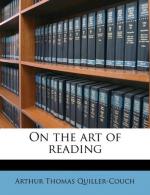But of another thing, Gentlemen, I am certain: that we were badly taught in that these books, while preached to us as equivalent, were kept in separate compartments. We were taught the books of Kings and Chronicles as history. The prophets were the Prophets, inspired men predicting the future which they only did by chance, as every inspired man does. Isaiah was never put into relation with his time at all; which means everything to our understanding of Isaiah, whether of Jerusalem or of Babylon. We ploughed through Kings and Chronicles, and made out lists of rulers, with dates and capital events. Isaiah was all fine writing about nothing at all, and historically we were concerned with him only to verify some far-fetched reference to the Messiah in this or that Evangelist. But there is not, never has been, really fine literature—like Isaiah—composed about nothing at all: and in the mere matter of prognostication I doubt if such experts as Zadkiel and Old Moore have anything to fear from any School of Writing we can build up in Cambridge. But if we had only been taught to read Isaiah concurrently with the Books of the Kings, what a fire it would have kindled among the dry bones of our studies!
Then said the Lord unto Isaiah, Go forth now to meet Ahaz, thou, and Shear-jashub thy son, at the end of the conduit of the upper pool in the highway of the fuller’s field.
Scholars, of course, know the political significance of that famous meeting. But if we had only known it; if we had only been taught what Assyria was—with its successive monarchs Tiglath-pileser, Shalmaneser, Sargon, Sennacherib; and why Syria and Israel and Egypt were trying to cajole or force Judah into alliance; what a difference (I say) this passage would have meant to us!
VIII
I daresay, after all, that the best way is not to bother a boy too early and overmuch with history; that the best way is to let him ramp at first through the Scriptures even as he might through “The Arabian Nights”: to let him take the books as they come, merely indicating, for instance, that Job is a great poem, the Psalms great lyrics, the story of Ruth a lovely idyll, the Song of Songs the perfection of an Eastern love-poem. Well and what then? He will certainly get less of “The Cotter’s Saturday Night” into it, and certainly more of the truth of the East. There he will feel the whole splendid barbaric story for himself: the flocks of Abraham and Laban: the trek of Jacob’s sons to Egypt for corn: the figures of Rebekah at the well, Ruth at the gleaning, and Rispah beneath the gibbet: Sisera bowing in weariness: Saul—great Saul—by the tent-prop with the jewels in his turban:
All its lordly male-sapphires, and rubies courageous at heart.
Or consider—to choose one or two pictures out of the tremendous procession—consider Michal, Saul’s royal daughter: how first she is given in marriage to David to be a snare for him; how loving him she saves his life, letting him down from the window and dressing up an image on the bed in his place: how, later, she is handed over to another husband Phaltiel, how David demands her back, and she goes:




